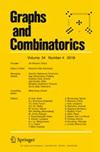Turán Numbers of Several Bipartite Graphs
IF 0.6
4区 数学
Q3 MATHEMATICS
引用次数: 0
Abstract
For graphs \(H_1,H_2,\dots ,H_k\), the k-color Turán number \(ex(n,H_1,H_2,\dots ,H_k)\) is the maximum number of edges in a k-colored graph of order n that does not contain monochromatic \(H_i\) in color i as a subgraph, where \(1\le i\le k\). In this note, we show that if \(H_i\) is a bipartite graph with at least two edges for \(1\le i\le k\), then \(ex(n,H_1,H_2,\dots ,H_k)=(1+o(1))\sum _{i=1}^kex(n,H_i)\) as \(n\rightarrow \infty \), in which the non-constructive proof for some cases can be derandomized.
多个二方图的图兰数
对于图(H_1,H_2,\dots ,H_k\),k-color Turán number \(ex(n,H_1,H_2,\dots ,H_k)\)是阶数为 n 的 k-color图中不包含颜色 i 的单色图(H_i\)作为子图的最大边数,其中 \(1\le i\le k\).在本说明中,我们将证明如果 \(H_i\) 是一个至少有两条边的二(2)方图,那么 \(ex(n,H_1,H_2,\dots 、H_k)=(1+o(1))sum _{i=1}^kex(n,H_i)\) as \(n\rightarrow \infty \), in which the non-constructive proof for some cases can be derandomized.
本文章由计算机程序翻译,如有差异,请以英文原文为准。
求助全文
约1分钟内获得全文
求助全文
来源期刊

Graphs and Combinatorics
数学-数学
CiteScore
1.00
自引率
14.30%
发文量
160
审稿时长
6 months
期刊介绍:
Graphs and Combinatorics is an international journal devoted to research concerning all aspects of combinatorial mathematics. In addition to original research papers, the journal also features survey articles from authors invited by the editorial board.
 求助内容:
求助内容: 应助结果提醒方式:
应助结果提醒方式:


